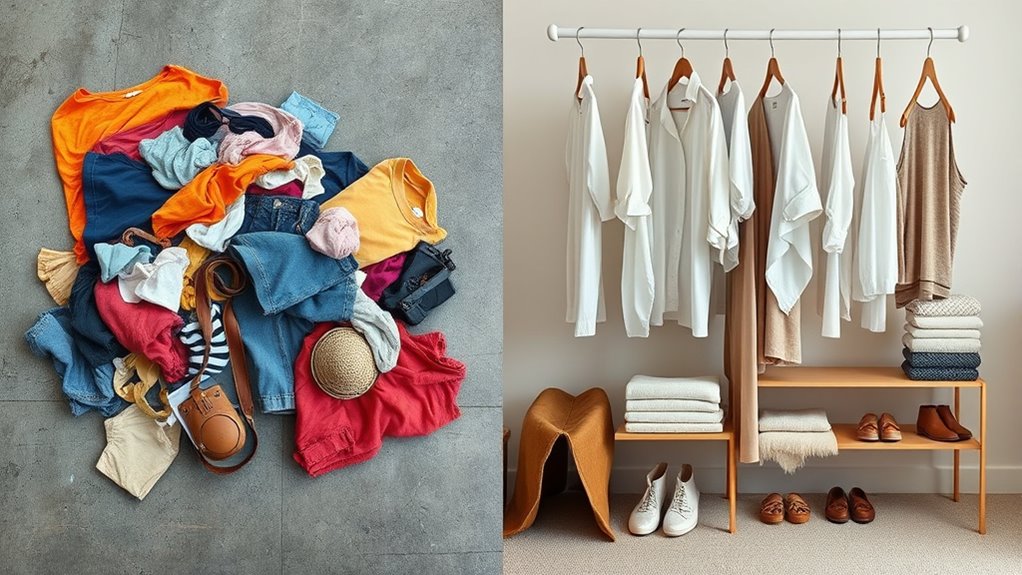Fast fashion lets you buy trendy clothes quickly and cheaply, but it’s linked to unethical labor, waste, and pollution. In contrast, slow fashion focuses on longer-lasting, sustainable pieces made with transparency and care, reducing environmental harm. Your choices directly affect workers and the planet. By choosing slow fashion, you support a more ethical and eco-friendly industry. To understand how your wardrobe impacts the world more deeply, keep exploring these differences.
Key Takeaways
- Fast fashion prioritizes rapid, low-cost production, leading to environmental waste and unethical labor practices.
- Slow fashion emphasizes quality, transparency, and sustainability to reduce waste and promote ethical sourcing.
- Consumer choices influence the fashion industry’s impact, with slow fashion supporting responsible brands and practices.
- Fast fashion’s disposable nature contributes to landfills, pollution, and resource depletion, harming the environment.
- Adopting slow fashion benefits the planet and workers by encouraging mindful consumption and durable, eco-friendly clothing.

In recent years, the fashion industry has become a battleground between two contrasting approaches: slow fashion and fast fashion. As a consumer, your choices directly influence this ongoing debate, especially when it comes to ethical sourcing and the environmental footprint of your wardrobe. Fast fashion thrives on quick production cycles, cheap labor, and low prices, but this often comes at a steep cost. Garments are produced rapidly, using materials that may lack transparency in their sourcing, which can lead to unethical labor practices. Meanwhile, the environmental footprint of fast fashion is significant. Mass production results in excessive waste, pollution, and a heavy reliance on non-renewable resources. When you buy fast fashion, you’re often supporting a cycle of disposable clothing that quickly ends up in landfills, contributing to environmental degradation.
Fast fashion’s rapid, cheap production harms the environment and perpetuates unethical labor practices.
On the other hand, slow fashion emphasizes quality, durability, and transparency. It encourages you to think about where your clothes come from and how they’re made. Ethical sourcing is a core principle here. By choosing brands that prioritize fair labor practices, you help ensure that workers are paid fair wages and work in safe conditions. Slow fashion brands often have transparent supply chains, allowing you to trace the origin of your garments and support ethical production. This approach also aims to reduce environmental impact by utilizing sustainable materials, minimizing waste, and implementing eco-friendly manufacturing processes. When you invest in slow fashion, your clothing tends to last longer, which means fewer replacements and less waste over time. Additionally, many slow fashion brands integrate advanced technology to improve sustainability and accountability in their supply chains.
Your decision between fast and slow fashion doesn’t just impact your wardrobe—it affects the planet and the people behind the garments. Fast fashion encourages a throwaway culture, where clothes are bought cheaply and discarded just as quickly. This cycle not only harms the environment through increased pollution and resource depletion but also perpetuates unethical labor practices in certain manufacturing regions. Conversely, choosing slow fashion aligns with a more conscious lifestyle. It promotes mindful consumption, where you prioritize quality over quantity and make informed choices about ethical sourcing. Supporting slow fashion brands can help reduce your environmental footprint by encouraging sustainable production methods and fostering a more responsible industry.
Ultimately, your wardrobe choices carry weight. Opting for slow fashion means you’re actively participating in a movement toward sustainability, ethical labor, and environmental stewardship. While it might require more effort and sometimes a higher price point, the long-term benefits for the planet and the people making your clothes are invaluable. By understanding the impact of your fashion choices, you can make a difference—one garment at a time.
Frequently Asked Questions
How Can I Identify Truly Sustainable Fashion Brands?
To identify truly sustainable fashion brands, look for those committed to ethical sourcing and transparent practices. Check if they disclose their supply chain details and labor conditions. Research their materials to make certain they use eco-friendly, durable fabrics. Support brands that prioritize fair wages and environmental responsibility. By doing so, you ensure your wardrobe choices promote sustainability and align with your values.
What Are the Financial Implications of Choosing Slow Fashion?
Choosing slow fashion might cost more upfront, but it’s a smart investment. You should do a cost analysis to see how quality pieces last longer, saving you money in the long run. This approach encourages smart investment strategies, focusing on durability and timeless style rather than quick trends. While initial expenses are higher, you’ll spend less over time, making slow fashion a financially sound choice that benefits your wardrobe and the planet.
How Does Fast Fashion Impact Local Economies?
Fast fashion impacts local economies by often prioritizing cheap imports over supporting community development. Did you know that fast fashion brands can generate as little as 2% of their revenue locally? This hampers economic growth in communities, limiting job opportunities and small business support. When you choose slow fashion, you help boost local economies, promote sustainable economic growth, and strengthen community ties.
Can Slow Fashion Be Practical for Everyday Wear?
Yes, slow fashion can be practical for everyday wear. You’ll find that versatile styling allows you to mix and match pieces easily, creating numerous outfits with fewer items. Plus, slow fashion emphasizes everyday durability, so your clothes last longer and stay in good condition despite frequent use. This approach not only supports sustainable choices but also helps you build a functional wardrobe that works for all occasions.
What Are the Best Ways to Recycle or Upcycle Old Clothing?
You can recycle or upcycle old clothing by donating it to charity, giving it a second life through clothing donation programs. Additionally, try fabric recycling—cutting up old garments to make new items like patches, bags, or cleaning rags. Get creative by transforming worn-out pieces into something unique, reducing waste and supporting sustainable fashion. These methods help extend your wardrobe’s lifespan and lessen environmental impact.
Conclusion
Choosing between slow fashion and fast fashion shapes more than just your wardrobe; it shapes your values, your planet, and your future. You can support sustainability, embrace quality, and reduce waste. You can make mindful choices, invest in timeless pieces, and stand for ethical practices. Your wardrobe reflects who you are—so choose thoughtfully, act intentionally, and wear your values proudly. Because your fashion choices today will define the world you’ll live in tomorrow.









